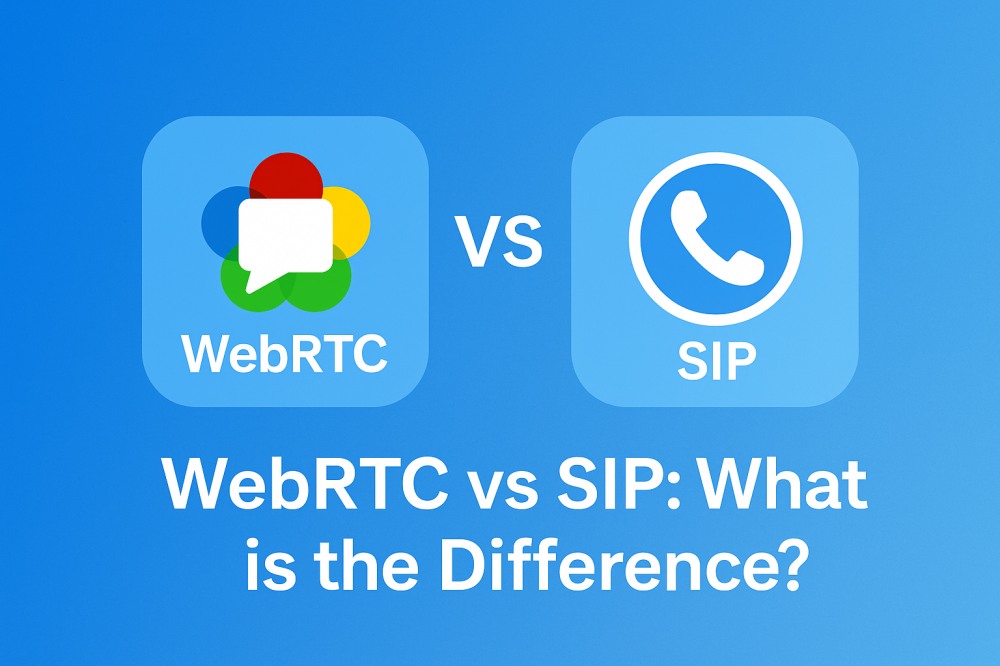WebRTC and SIP are two powerful communication protocols that enable real-time voice and video communication. While WebRTC powers modern browser-based communication, SIP is widely used in traditional VoIP systems. Understanding WebRTC vs SIP differences is essential for developers choosing the right protocol for their application.
What is WebRTC?
WebRTC (Web Real-Time Communication) is an open-source project that allows web browsers and mobile apps to conduct real-time voice, video, and data communication without the need for plugins. It supports peer-to-peer communication and is integrated directly into modern browsers like Chrome, Firefox, Safari, and Edge. WebRTC enables developers to build interactive communication tools easily, such as video conferencing apps, customer support chats, and live streaming platforms.
Pros and Cons of WebRTC
Before choosing WebRTC for your application, it’s important to weigh its advantages and limitations. Below are the main pros and cons developers should consider:
Pros of WebRTC:
- Plugin-free, browser-native support
- Supports audio, video, and data channels
- End-to-end encryption and security
- Cross-platform and mobile-friendly
- Low latency suitable for live applications
Cons of WebRTC:
- Requires separate signaling implementation
- Browser compatibility may vary
- Firewall/NAT traversal can be complex
- No built-in support for call control features like transfer or hold
- May require more frontend-heavy development
How Does WebRTC Work?
WebRTC works through a set of JavaScript APIs that provide access to devices (camera, microphone), manage peer-to-peer connections, and transmit data in real time. It uses protocols like SRTP (Secure Real-time Transport Protocol) for media encryption and ICE (Interactive Connectivity Establishment) to manage NAT traversal and peer connection. Signaling, which is required to initiate and maintain connections, is not defined by WebRTC and must be implemented separately, typically via WebSocket or HTTP. Once the signaling process is complete, media streams and data channels are established directly between peers.
What is SIP?
SIP (Session Initiation Protocol) is a signaling protocol used to initiate, manage, and terminate voice and video communication sessions over IP networks. It is the foundation of many VoIP systems and works well with traditional telephony networks. SIP supports a wide range of features including call setup, modification, and teardown, making it a staple in enterprise telephony systems and call centers.
Pros and Cons of SIP
SIP is a mature and flexible protocol, but it’s not without trade-offs. Here’s a breakdown of its main strengths and weaknesses:
Pros of SIP:
- Mature and well-documented protocol
- Interoperable with PSTN and VoIP systems
- Feature-rich: supports call hold, forwarding, transfers
- Scalable for enterprise environments
- Broad support in hardware and software solutions
Cons of SIP:
- Requires SIP servers and configuration
- Not browser-native (needs softphone or app)
- More overhead for integration into modern apps
- Higher learning curve for developers
- Limited in direct peer-to-peer browser support
How Does SIP Work?
SIP operates at the application layer and establishes sessions between users through request and response messages. It works with other protocols like RTP (Real-time Transport Protocol) to transmit media. SIP servers (proxy, registrar, and redirect servers) handle user registration, authentication, and routing of calls. It uses SIP addresses (like email addresses) to identify users. SIP can operate over UDP, TCP, or TLS, and is often implemented with PBX systems, IP phones, and SIP trunks.
Key Differences between WebRTC vs SIP
WebRTC and SIP serve overlapping but distinct purposes. WebRTC is ideal for browser and mobile app communication, offering built-in media and data channels. SIP, on the other hand, excels in legacy VoIP systems with advanced call control features. Here are a deep compariosn between WebRTC vs SIP:
| Feature | WebRTC | SIP |
|---|---|---|
| Use Case | Browser/mobile RTC | Enterprise VoIP, call centers |
| Media Transport | Built-in via SRTP | Requires RTP setup |
| Signaling | Not included (custom needed) | Included (standardized) |
| Device Access | Direct API access in browser | Not applicable |
| Integration Ease | Easier for web apps | More setup required |
For developers building cross-platform real-time communication apps, ZEGOCLOUD provides comprehensive SDKs that simplify WebRTC implementation. With prebuilt features and reliable infrastructure, ZEGOCLOUD bridges the gap between raw protocol complexity and production-ready applications.
When to Use WebRTC?
Use WebRTC when you need browser-based real-time communication with minimal setup. It’s perfect for applications like video conferencing tools, online classrooms, telehealth apps, and customer support chat. If your app targets both desktop and mobile users and requires fast, secure peer-to-peer communication, WebRTC is the modern solution of choice.
When to Use SIP?
SIP is ideal for enterprise telephony environments, such as PBX systems, VoIP phones, and call centers. If your application needs robust call control features, PSTN integration, or compatibility with legacy systems, SIP provides a reliable and standardized approach. It’s best suited for backend-heavy telecom infrastructure.
How ZEGOCLOUD Supports WebRTC Development
ZEGOCLOUD empowers developers to build scalable WebRTC-based applications with ease. Its real-time SDKs support voice, video, and messaging features out of the box. Whether you’re developing a conferencing tool, a social app, or a virtual classroom, ZEGOCLOUD handles media transmission, NAT traversal, and signaling challenges so you can focus on user experience. With global infrastructure and cross-platform compatibility, ZEGOCLOUD accelerates your product’s time to market.
Conclusion
Both WebRTC and SIP offer powerful capabilities for real-time communication, but they cater to different needs. WebRTC shines in modern, browser-based applications, while SIP remains strong in enterprise telephony. By leveraging solutions like ZEGOCLOUD, developers can simplify WebRTC implementation and focus on building user-centric communication experiences.
Let’s Build APP Together
Start building with real-time video, voice & chat SDK for apps today!










